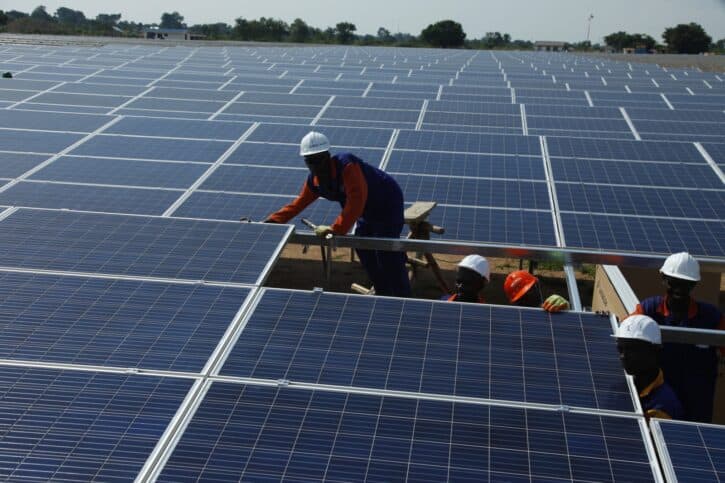Norway pledges $1,16 «fresh» billions to replace fossil fuels in developing countries
The new Norwegian initiative should allow project sponsors and investors to access investment capital which is «cheaper» than otherwise available in the market.

Engineers working at at a solar plant in Soroti about 300 kilometers east of Uganda capital Kampala. (Photo: AP Photo/Stephen Wandera/NTB)
As negotiators and world leaders are preparing for tough discussions on how to finance the Paris agreement at the upcoming climate summit in November in Glasgow, the Norwegian government led by Prime Minister Erna Solberg this week announced a $1,16 billion initiative to step up the financing of clean energy alternatives in developing countries.
The money allocated from the Norwegian government is supposed to offer terms that will unlock equity capital and debt from project sponsors and lenders, thereby generating up to $10 billion of new investments in clean energy over a 5 year period, i.e about 2 billion a year.
To put these numbers in context, IEA estimates that total clean energy investments in developing countries amounted to $150 billion in 2020. The energy agency further estimates that in order to put the world on track to reach net-zero emissions by 2050 in line with the Paris agreement, these investments would need to increase to $1 trillion by 2030.
The new and ambitious pledge from Norway comes in addition to the existing climate finance commitments from the country, including Norway’s International Climate and Forest initiative (NICFI) and the funds and pledges made towards The Green Climate Fund and other multilateral initiatives. According to government sources, Norway spends about $800 million per year in climate financing as part of its development aid budget.
The climate finance facility will initially be financed with a yearly allocation of 1 billion NOK ($116 millon) over five years from the national budget, and an equal amount per year allocated from the capital base of Norfund, Norway’s fund for developing countries. The government and Norfund targets to raise additional funding so that the total funding generated is 5-fold, i.e more than $10 billion over a 5 year period.
Investment capital at lower cost
There is no lack of climate finance announcements these days, so what is unique about the Norwegian initiative?
The key to answer that question is in my view the return requirements set by the Norwegian government and Norfund, as well as Norfund’s ability to work efficiently with private partners and project sponsors to keep administration and transaction fees low.
On the first question, I believe we can expect that the return requirement set for the $1,2 billion allocated from the national budget and from Norfund will be on a level comparable to the 3-4 % p.a. return expectation set for Norway’s sovereign wealth fund. This is markedly below what commercial investors would require in most emerging markets.
Provided that the cost of managing the fund can be kept at a minimum, the new Norwegian initiative should therefore allow project sponsors and investors to access investment capital which is «cheaper» than otherwise available in the market and therefore can be expected to unlock additional investments in Asia and Africa to replace coal and other fossil fuel generators.
At the launch of the initiative July 8, Norway’s development minister Dag Inge Ulstein said: «The new fund is intended to mobilise investments in renewable energy far more quickly than would otherwise have been the case. The fund is the beginning of a new partnership between public and private capital that can yield returns on investments, reduce greenhouse gas emissions and increase climate finance.»
How to attract more projects
But how will the new facility get access to investment-ready projects? The ideal target is of course large wind and solar plus storage power plants that directly can replace existing baseload coal fired power plants.
In reality we have learned that it takes several years for such «ideal» investment targets to mature. In the meantime, and as further elaborated in this article, much can in my view be achieved with a market-based approach by setting a price on the carbon in the target countries that will be removed through the investment proposal, and converting the carbon value of the project to an equity investment by the new fund.
This way, a large number of developers and project sponsors will be able to propose investment projects, giving the manager the ability to select the most efficient carbon removal projects regardless of size.
